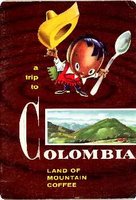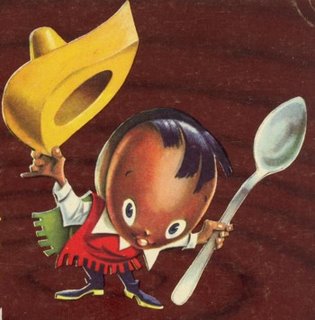Beanie the Genie
I'll be writing about a coffee booklet again today. Lest you think that I'm on some kind of coffee binge, rest assured that as there is no rhyme or reason to which booklets I share with you each day, it may be that I won't write about coffee again for a long, long time. On the other hand, I might come across another coffee booklet tomorrow that strikes my fancy.
 A Trip to Columbia: Land of Mountain Coffee (not dated, 36 pp) was published and distributed by a trade organization called the National Federation of Coffee Growers of Colombia.
A Trip to Columbia: Land of Mountain Coffee (not dated, 36 pp) was published and distributed by a trade organization called the National Federation of Coffee Growers of Colombia.
The Federation, founded in 1927 and headquartered in Bogota, Colombia, was (is) a non-profit, non-political organization similar to the United States Department of Agriculture. It presently represents a collective of over 560,000 Colombian coffee growers. Besides Colombia, they also have offices in the United States and in other countries around the world.
Colombian Coffee is not a brand of coffee, but rather an origin of the coffee. Most coffee brands are a blend of Colombian Coffee and coffee of other origins. There are brands, however, that consist entirely of 100% Colombian Coffee.
One of the primary functions of this group is promoting the consumption of Colombian Coffee. In an overview of their past advertising practices, their website states:
"To promote Colombian Coffee consumption it was first necessary to let consumers know why Colombian Coffee is a better product, hence to teach them the amount of care and labor that goes into growing and harvesting Colombian Coffee as well as the ideal climatic conditions that are hard to find in other countries."
This promotional booklet fits the bill exactly. While it does provide information of some value to adults, its format indicates to me that it was probably part of an educational campaign directed towards children. Including children in the consumer educational process was not unusual. Another example of this is the United Fruit Company, who, in 1929, began printing educational material for school classrooms which promoted banana consumption.
A Trip to Columbia is not dated, but I believe it was probably published around 1958 or 1959. The booklet explains that the annual coffee crop production in 1927 yielded 2,300,000 bags and in 1958 the number had increased to 7,300,000 bags. (In contrast, the projected production figure for 2005 was 11,500,00 bags.)
This booklet does not contain any recipes at all. It's basically divided into three sections:
The first portion of the booklet is a story about the history of coffee. It's illustrated with colorful, cartoon-type drawings and is narrated by a character who is called Beanie the Genie. Beanie, a Colombian coffee bean sporting a bright yellow sombrero (hat), is shown on the front cover. Perhaps Beanie was a character intended for children, but regardless, his days as an advertising icon were numbered, as the Juan Valdez character and spokesman was created in 1959. Juan Valdez, the famous cafetero (coffee farmer) remains as a well-known figure today. You will find the Juan Valdez logo on many Colombia Coffee products.

The second section of the booklet is the portion which focuses on the growing and harvesting of the Colombian Coffee beans. This section is illustrated with old color and black/white photos (reminiscent of the photos found in most geography textbooks from that same time period) of real people on real farms harvesting and growing real coffee beans. Beanie the Genie refers to this section of photographs as his "family album."
The third section discusses the National Federation of Coffee Growers of Colombia and how the organization functions for the coffee farmers and the coffee trade.
The inside of the front cover is a color drawing showing a Coffee Map of Colombia. It indicates the coffee growing areas, mountain ranges and the Federation offices. Inside the rear cover is another color map of Columbia showing Other Important Crops of Colombia. Forest products, wheat, cotton, emeralds, tobacco, rubber, sugar, cattle and bananas are all represented.
 A Trip to Columbia: Land of Mountain Coffee (not dated, 36 pp) was published and distributed by a trade organization called the National Federation of Coffee Growers of Colombia.
A Trip to Columbia: Land of Mountain Coffee (not dated, 36 pp) was published and distributed by a trade organization called the National Federation of Coffee Growers of Colombia.The Federation, founded in 1927 and headquartered in Bogota, Colombia, was (is) a non-profit, non-political organization similar to the United States Department of Agriculture. It presently represents a collective of over 560,000 Colombian coffee growers. Besides Colombia, they also have offices in the United States and in other countries around the world.
Colombian Coffee is not a brand of coffee, but rather an origin of the coffee. Most coffee brands are a blend of Colombian Coffee and coffee of other origins. There are brands, however, that consist entirely of 100% Colombian Coffee.
One of the primary functions of this group is promoting the consumption of Colombian Coffee. In an overview of their past advertising practices, their website states:
"To promote Colombian Coffee consumption it was first necessary to let consumers know why Colombian Coffee is a better product, hence to teach them the amount of care and labor that goes into growing and harvesting Colombian Coffee as well as the ideal climatic conditions that are hard to find in other countries."
This promotional booklet fits the bill exactly. While it does provide information of some value to adults, its format indicates to me that it was probably part of an educational campaign directed towards children. Including children in the consumer educational process was not unusual. Another example of this is the United Fruit Company, who, in 1929, began printing educational material for school classrooms which promoted banana consumption.
A Trip to Columbia is not dated, but I believe it was probably published around 1958 or 1959. The booklet explains that the annual coffee crop production in 1927 yielded 2,300,000 bags and in 1958 the number had increased to 7,300,000 bags. (In contrast, the projected production figure for 2005 was 11,500,00 bags.)
This booklet does not contain any recipes at all. It's basically divided into three sections:
The first portion of the booklet is a story about the history of coffee. It's illustrated with colorful, cartoon-type drawings and is narrated by a character who is called Beanie the Genie. Beanie, a Colombian coffee bean sporting a bright yellow sombrero (hat), is shown on the front cover. Perhaps Beanie was a character intended for children, but regardless, his days as an advertising icon were numbered, as the Juan Valdez character and spokesman was created in 1959. Juan Valdez, the famous cafetero (coffee farmer) remains as a well-known figure today. You will find the Juan Valdez logo on many Colombia Coffee products.

The second section of the booklet is the portion which focuses on the growing and harvesting of the Colombian Coffee beans. This section is illustrated with old color and black/white photos (reminiscent of the photos found in most geography textbooks from that same time period) of real people on real farms harvesting and growing real coffee beans. Beanie the Genie refers to this section of photographs as his "family album."
The third section discusses the National Federation of Coffee Growers of Colombia and how the organization functions for the coffee farmers and the coffee trade.
The inside of the front cover is a color drawing showing a Coffee Map of Colombia. It indicates the coffee growing areas, mountain ranges and the Federation offices. Inside the rear cover is another color map of Columbia showing Other Important Crops of Colombia. Forest products, wheat, cotton, emeralds, tobacco, rubber, sugar, cattle and bananas are all represented.

0 Comments:
Post a Comment
<< Home